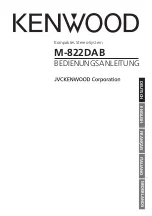
DTM436 DTM437
19
CAN
identi-
fier
x-byte data frame
0xCEF
EB14
0x01
0xA0
0x01
0x00
0x02
0x00
0x04
0x00
0xAA
0xBB
0xCC
0xDD
Response: Master ← ECU
CAN identifier
x-byte data frame
0xCEF14EB
0x01
0xA0
0x01
0x00
For successful reading and writing, the ID tag must be in the detection range of the read/write
head. In the event of data read and write errors, the status byte responds with 0x0B.
9.5 Settings
9.5.1 Device address (0x2000) and baud rate (0x2001)
Valid values for the device address are: 0 to 253.
Preferably use the preset device address. Via "address claiming" the device address can be changed.
Valid values for the baud rate are: 250 kBits/s, 500 kBits/s.
Default settings of the device:
w
Device address (ECU): 235
w
Baud rate: 250 kBits/s
Use the set device address only once in the CAN network.
u
Use “address claiming” in the CAN network to avoid conflicts. (
Only after resetting the read/write head will a changed device address and baud rate become
effective.
u
Reset the read/write head with the reset command or hardware reset. (
9.5.2 Address claiming
The read/write head supports “dynamic address claiming”.
By default, the device address is 235. With the device address, the sensor logs in to the network
during start-up. Unless there is an address conflict with other network participants, the sensor starts
communication automatically.
Arbitrary address capable (CA)
If the set address of the device is already used in the network, the participant with a higher priority will
be accepted by the network. The rejected network participant with a lower priority will be assigned
another valid device address.
9.5.3 Reset read/write head
By writing the value “1” to the parameter index 0x2002 the read/write head is reset.
After writing the value, the read/write head is reset immediately. No response frame is sent from
the read/write head.




































